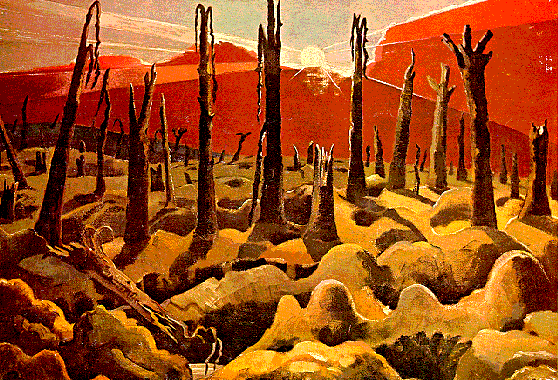War Requiem Analysis (original) (raw)
Musical Analysis of the War Requiem
[ Requiem Aeternam |Dies Irae |Offertorium |Sanctus |Agnus Dei |Libera me ]

Paul Nash: 'We are building a New World'
Imperial War Museum, London
The Requiem aeternam begins with a slow, dragging Introitwhich gradually builds with longer phrases and more orchestration to a grand opening. The long introduction signifies the beginning of a truly large scale work.
For the first time, the F#-C tritone is heard in the knell of the chimes. This is a unifying interval in the piece which is often heard when the text refers to rest. Ironically, the augmented fourth is rather clashing and gives the feeling of unrest.
The tenor soloist is then heard, singing Owen's "Anthem for Doomed Youth." The orchestra's accompaniment suggests gunfire and the wailing of shells. Very often in the War Requiem, Britten's music follows the text quite literally -- when instruments are referred to in the poetry, they are heard in the music, and onomatopoeic words are illustrated musically.
The Requiem aeternam ends with the Kyrie. Traditionally, the Kyrie was merged with the Introit, but Britten chose to separate them with the Anthem. Rather than dividing the movement, though, the Owen poem serves to unify it, drawing its theme from both the Introit and the Kyrie.
The Dies Irae, with its nine sections, is the longest part of the War Requiem and can be thought of as the center of the work, even though it is only the second of six parts. Four poems -- Voices, The Next War,Sonnet On Seeing a Piece of Our Artillery Brought Into Action, andFutility -- are interspersed with the Latin text, and once again serve more to unify than to separate the Dies Irae.
The introduction by the brass is in 4/4 time and depicts the "Tuba mirum spargens sonum" imagery sung a short time later. When the choruscomes in, though, the meter shifts to and asymmetrical 7/4, generating a mood of fear and uncertainty. Contributing to this are blurred shifts between major and minor.
The unusual meter used by Britten is a clever way to prevent the trochaic tetrameters of the Latin text from sounding repetitive or boring. He creates the feeling of what Palmer calls a "crippled march" by constantly shifting the musical accent.
The Offertorium begins with the boys singing 'Domine Jesu Christe.' This is an introduction to Owen's poem, "The Parable of the Old Men and the Young." As the tenor and baritone begin retelling it, the accompaniment shifts from the main orchestra to the smaller chamber orchestra. The poem is an ironic inversion of the familiar story of Abraham and Isaac in which Abraham sacrifices his son despite offers made by an angel sent from heaven to save the boy. The last lines of the poem,
But the old man would not so,
but slew his son, -
And half the seed of Europe, one by one
underline Owen's bitterness toward the leaders who sent their countries' children off to war. The soloists repeat the last line as the boys, seemingly unaware of them, provide an ethereal backdrop. The Latin Hostias text sung by the boys and the soloists' parable fit together seamlessly -- both referring to sacrifice.
The musical themes of this section borrow from an earlier work of Britten; his Canticle II, 'Abraham and Isaac', Op. 51, 1952. It is a solo vocal piece which retells the Biblical version of the parable.
A short pause from the themes of war and death present in the rest of the Requiem is offered by the fourth section. The Sanctus and Benedictus are "messages of serene joy, even in a mass for the dead, and Britten accepts them as such, however ambiguous the attitude in which he then looks back on them through the Owen poem he appends", Palmer writes. The Sanctus has a hopeful, joyous mood, and even the F#-C tritone loses its oppressiveness. Britten comments on the liturgical text with Owen's poem, "The End", returning to the previous darker mood. The "loud clouds" in the second line of the poem seem to cast a shadow over the jubilance of Sanctus.
The Agnus Dei is the last section of the Latin Missa pro defunctis, and Britten's interpretation of it seems to have a feeling of acceptance. The chorus pleads,
Lamb of God, that takest away the sins of the world,
grant them rest.
Interspersed is "At a Calvary Near the Ancre", in which Owen berates the patriots who never fight themselves. Like Christ, the soldiers are those who "lay down their life" and their eternal rest is called for. Britten adds the words "Dona nobis pacem" to the end of the Agnus Dei. The tritone is more evident here than any other part of the War Requiem.
The Latin text for the Libera me actually comes from the Burial service, not the Mass for the Dead. The mood is even more ominous than the Dies Irae; it speaks of eternal death, not just death and judgement. The slow, plodding beginning gradually accelerates, becoming louder and more insistent. Finally, the orchestra returns to the 7/4 Dies Irae theme, with terrible interjections of panic from the chorus. There is an apocalyptic climax and collapse, and the orchestra and voices fade away.
The tenor enters with one of Owen's most famous poems, "Strange Meeting." In it, he relates a dream-like encounter with a German soldier. The conclusion breaks off -- "Let us sleep now..." and the chorus finishes in the same manner as the Requiem Aeternam with "Requiescant in pace. Amen."
[ Main | Biography |War Requiem | Links | Bibliography | Index ]